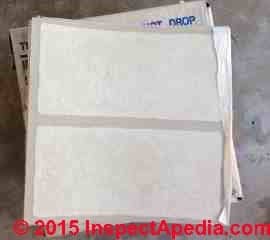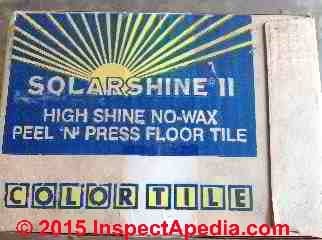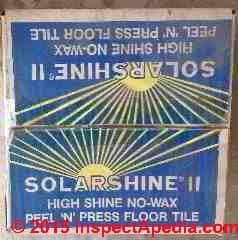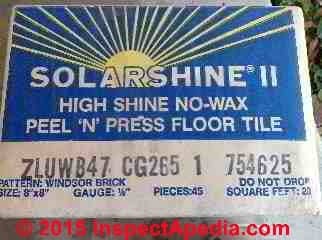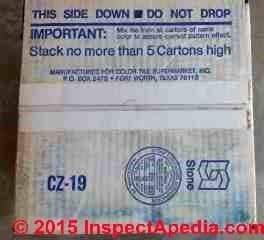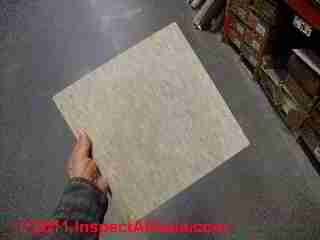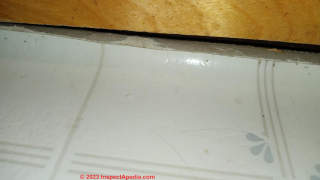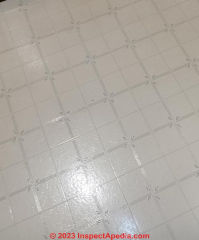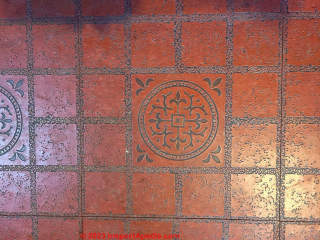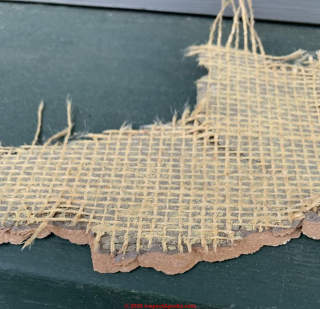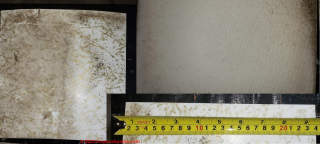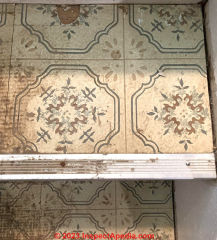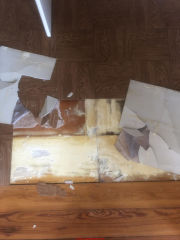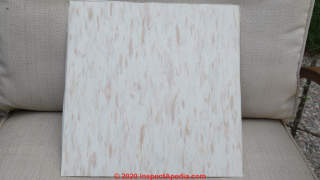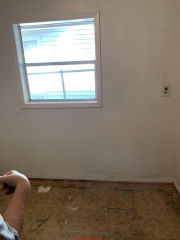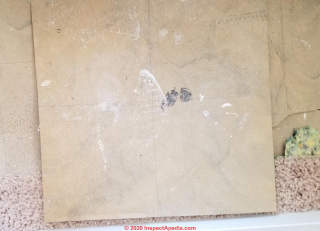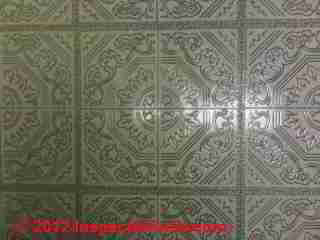 Self-Adhesive "Peel & Stick" Vinyl-Asbestos Floor Tiles Identification Photo Guide
Self-Adhesive "Peel & Stick" Vinyl-Asbestos Floor Tiles Identification Photo Guide
- POST a QUESTION or COMMENT about asbestos in peel and stick flooring materials & flooring made or sold in the U.S., Canada, or other countries after 1980
Asbestos-Containing Peel-and-Stick Floor Tiles:
This article describes self-adhesive "peel and stick" vinyl floor tiles that contain or may contain asbestos. We include product names, descriptions, and photographs of asbestos-containing stick-on floor tile products including materials used in homes in the U.S. and Canada into at least the early 1980's.
InspectAPedia tolerates no conflicts of interest. We have no relationship with advertisers, products, or services discussed at this website.
Photo Guide to Peel & Stick or Self Adhesive Floor Tiles that May Contain Asbestos
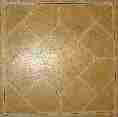 Asbestos is safe and legal to remain in homes or public buildings as long as the asbestos
materials are in good condition and the asbestos can not be released into the air.
Asbestos is safe and legal to remain in homes or public buildings as long as the asbestos
materials are in good condition and the asbestos can not be released into the air.
1980's - Armstrong Self-Adhesive Floor Tiles - Photos & information about asbestos containing vinyl asbestos self-adhering "peel and stick" flooring that may contain asbestos. Armstrong, American Biltrite, or Amtico peel and stick asbestos floor tile identification & asbestos content.
Peel & Stick or Self-Adhesive Stick-on Tiles, Current - modern peel and stick floor tiles.
1982 - Armstrong Self-Adhesive Floor Tiles - Vernay Peel-and-Stick
Do Peel and Stick Floor Tiles Contain Asbestos?
- VERNAY PEEL & STICK peel and stick floor tiles. [Click to enlarge any image]
Armstrong Peel-and-Stick Floor vinyl floor tiles were introduced late in 1969 and continue in popular use today.
Some, but apparently not all self-adhesive floor tiles made by Armstrong during the period 1969 - 1982 contained asbestos. The company stopped manufacturing these tiles with asbestos in December of 1982.
Not all adhesive floor tiles produced during this period contain asbestos. It is necessary to know the flooring product model number or collection name of a tile in question, or to submit a sample to an asbestos test laboratory to make a final determination.
 The peel-and-stick Armstrong floor tile shown in our photograph (above left) was from Armstrong's Vernay series, introduced in 1980 and discontinued in 1982.
The peel-and-stick Armstrong floor tile shown in our photograph (above left) was from Armstrong's Vernay series, introduced in 1980 and discontinued in 1982.
This product never contained asbestos. - information courtesy of Armstrong Corporation
Photo at left: Armstrong Vernay-pattern self-adhesive floor tile, contributed by reader P.S. and discussed below
at POST a QUESTION or COMMENT .
The flooring in this photograph was observed in a home built in 1984, two years after the Vernay series product line was discontinued, proving the point that floor tiles, both containing or free of asbestos, may have been purchased and installed several years past the last date of actual manufacture of the product.
Other asbestos containing Vernay pattern floor tiles are described
at 1980-1988 ARMSTRONG EXCELON VINYL ASBESTOS FLOOR TILES.
Other Asbestos-Containing Peel-and-Stick self-Adhesive Floor Tiles
American Biltrite Zip-Stik Asbestos-Containing Peel and Stick Flooring from the early 1980's
1980's American Biltrite Zip Stick & Amitco Sunbeam Pattern ZipStik flooring
American Biltrite Zip Stick 12x12 tiles in fact do contain asbestos as do a Canadian version of this flooring illustrated here.
The Amitco Sunbeam pattern Zip Stik floor tiles in our photos (below) contributed by reader P.T. look the same except the packaging (if you have an original tile carton) will read "Manufactured by American Biltrite Canada".
These nominal 12"x12" self adhesive floor tiles were 305mm x 305mm, 0.080" or 2.03mm gauge (thickness).

These self-adhesive floor tiles were installed in a home built in the 1980's. The owner had a sample of these tiles tested for asbestos content and reported
"The tests came back positive with Asbestos 5% Chrysotile. The tile was manufactured in Canada in 1981. "
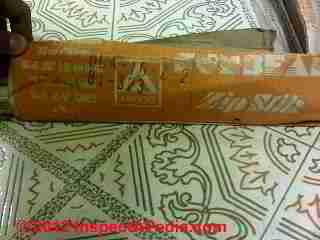
At left in a third image of self adhesive floor tiles that contain asbestos we include additional packaging materials that illustrates how lot numbers may appear (the black stamped data).
If you can identify your floor tile collection name or model number, laboratory testing of the sample to screen for asbestos may be unnecessary.
See ASBESTOS FLOOR TILE PHOTO ID GUIDE or send us a photograph of the flooring that you are trying to identify. Use the email address found at CONTACT.
Watch out: even if your vinyl tile or sheet vinyl flooring was installed some time after 1980, it is possible that an installer used 1980 or prior flooring materials that contained asbestos. Handle flooring demolition or grinding, sanding, polishing appropriately.
1970's Peel n Stick Adhesive Floor Tiles Containing Asbestos
Solar Shine II Peel 'n' Stick Floor Tiles sold by the Color Tile Supermarket Corporation: 2% asbestos?
Do you have any information about solar shine II peel and press tiles. They were made for Tile City. My home was built in 1969, but I suspect these were installed after then. I have had no luck finding info as to whether they contain asbestos. I have a box of spare tiles, but it gives no information.
- J.M. 8 Jul 2015
Reply:
Please send me some sharp photos of both sides of the tile, packaging, and tile dimensions and I'll research the question further.
Reader follow-up:
Solarshine II High Shine No-Wax Peel 'N' Press Floor Tile Packaging, vendor address, pattern Windsor Brick 8" x 8" x 1/8" thick peel and stick flooring
P.N. # ZLUWB47 CG265 1 754625 was produced for Color Tile Supermarket, Inc. in Texas and other U.S. states.
I sent a tile to a lab. They contain 2% asbestos. - J.M. private email to DF 25 July 2015
Reply: History of Solarshine Floor Tiles & Color Tile Supermarket, Inc., vs. Asbestos Content of Flooring
Important but curious lab results, JM. I have found that most peel and stick self-adhesive floor tiles made before the early to mid 1980's and as late as 1986 contained at least some asbestos. Asbestos is likely to be in either a filler in the vinyl product or in the paper-like backing to which the tile's upper surface or pattern was adhered.
Timm (1980) specifically includes asbestos as a filler used in the tiles themselves in percentages of 60-85% of the tile composition and our own extensive citation of Rosato and others describes similar asbestos filler proportions.
See details at ASBESTOS TILE MANUFACTURE
In my experience when asbestos was deliberately used in flooring products such as vinyl asbestos floor tiles or sheet flooring, lab tests find very high percentage of asbestos. Especially in the less-flexible vinyl asbestos tiles where asbestos powder was used as a filler. Two percent is low enough that I'm surprised, and am curious about where in the flooring it may have actually been used.
Asbestos also showed up in some tile mastic adhesives but those wouldn't apply to a "peel and stick" floor.
Asbestos does show up in some peel and stick flooring including some Armstrong products I've examined in homes dating from the 1970's.
I would much like to see the lab report itself.
I have done fairly extensive search for Solar Shine Peel and Stick flooring including through patents and Google scholar without finding any interesting results.
Your packaging notes that "Solar Shine Peel 'n' Press" flooring was manufactured for Color Tile Supermarket, Inc., POB 2475, Fort Worth TX 76113 in the U.S. Tel: 1-800-688-8063
Zip-code use began in the U.S. as early as 1963. Color Tile Supermarket was registered as a business in Texas on 12/29/1978 and was incorporated elsewhere a bit earlier.
Color Tile Supermarket was incorporated in 1975, filing as a foreign entity in California in that year (the company may or may not actually have been a foreign entity) and began operating under bankruptcy in 1996 and by 1997 most of its stores in the U.S. had been closed.
"Color Tile Supermart, Inc. filed as a Foreign For-Profit Corporation in the State of Texas and is no longer active. This corporate entity was filed approximately forty years ago on Monday, June 23, 1975 as recorded in documents filed with Texas Secretary of State. - retrieved 25 July 2015, original source: Corporation Wiki information website http://www.corporationwiki.com/p/hkpqh/color-tile-supermart-inc.
The company was involuntarily dissolved and was inactive as of 2000 or previously. Considering that its early flooring products were produced in the 1970's, it's reasonable that at least some would have contained asbestos. But the 2% finding of your lab remains curious.
My research on some other "non-asbestos" products found to contain trace levels in lab tests found that on occasion a product was manufactured at a facility where high levels of asbestos had been or continued to be present for use in other products and that there was cross-contamination.
As we do not have and won't be likely to obtain the actual formula nor actual production facility for your floor tiles I'm left guessing that this might be the case for your product as well.
Asbestos content of the adhesive in self-stick floor tiles
Is asbestos also likely to be present in the adhesive used with self-adhesive or peel-n-press or peel and stick floor tiles? Probably not.
Certainly asbestos was found in some older tile mastic adhesives used with thicker glue-down vinyl-asbestos floor tiles and some sheet flooring.
See MASTIC, CUTBACK ADHESIVE, FLASHING CEMENT ASBESTOS
Self-adhesive flooring patent research gives some dates and formulas or general chemical constituents and properties for these self adhesive products.
Timm (1980) specifically includes asbestos as a filler used in the tiles themselves in percentages of 60-85% of the older vinyl-asbestos tile composition and our own extensive citation of Rosato and others describes similar asbestos filler proportions.
But a different type of adhesive is used on self-stick floor tiles. That adhesive, pre-applied to the tile back surface, is kept intact and tacky and tiles are prevented from sticking together while in their package by a peel-off waxed paper or similar separator.
Kamata (1974) in describing a patent for self-sticking adhesives makes no mention of asbestos.
- Haas, Heinz, and Klaus-Dieter Struve. "Self-adhesive floor covering." U.S. Patent 4,554,194, issued November 19, 1985. Patent excerpt:
The surface of a covering which is to face a floor is at least in part constituted by an adhesive capable of forming a bond. This enables the covering to be readily applied to the floor. The surface may be covered by a protective foil which prevents the covering from sticking to other objects and is removed before applying the covering to the floor. ...
In certain instances, the synthetic resins contained in coverings for floors, walls and ceilings form chemical compounds with the adhesives.
Not infrequently, such a chemical compound causes the synthetic resin to undergo relatively rapid aging so that the synthetic resin becomes unsightly after a fairly short time interval.
Accordingly, the adhesive must be selected with great care and the selection of the adhesive should be performed by a person skilled in the art of applying coverings. If the adhesive is selected improperly, the covering may quickly become unsightly thereby necessitating premature replacement of the covering. - Kamata, T., K. Katagiri, and M. Sakaguchi. "Self-sticking material and a process for producing the same." U.S. Patent 3,813,278, issued May 28, 1974. Excerpt:
A sticking material has also been produced by coating a 'heat gelled composition comprising 100 parts, by weight, of polyvinyl chloride and 50 to 100 parts of a plasticizer on a'releasing paper; its peel strength and sticking strength measured by the methods described hereinafter are only 3 to 20 g./3 cm. and 350-550 g./cm. respectively. ...
The self-sticking composition used for the self-sticking material according to this invention comprises parts, by weight, of an ethylene-vinyl acetate/vinyl chloride graft polymer, 5 to 30 parts of plasticizer, and if desired, 0.5 to 5 parts of a stabilizer with or without 0.1 to 0.5 part of a lubricant.
The self-sticking composition is laminated by a calender or an extruder on a releasing paper, or, alternatively, a solution of the self-sticking composition in an organic solvent is coated by a coater, such as an air-knife-, a reverse rollor a blade coater, on a releasing paper, then a base sheet is laminated on the film of self-sticking composition, if necessary, by an adhesive.
The self-sticking material thus obtained may be printed and/or embossed for a certain use, for example, a sticker and decorating purposes; however, such treatment is unneeesary for a masking sheet and protecting sheet. - Timm, Walter C. "Self-adhesive plastic tile." U.S. Patent 4,195,107, issued March 25, 1980. Exerpt:
Plastic tile or similar items are disclosed having an adhesive backing suitable for adhesion to walls. The tiles are formulated from a vinyl chloride based resin and filler, and include a plasticizer of the formula: ##STR1## which R is a lower alkyl radical and R' is an aryl, aralkyl, or an alkaryl radical.
A hot melt type pressure sensitive adhesive coating is provided on the plastic tile, the coating comprising a vinylic copolymer made of a minor portion of styrene units or derivatives thereof, and a major portion of butadiene, isoprene, or other similar units. ...
Vinyl chloride based resin suitable for use in tiles of the invention may be any of the conventional vinyl chloride based resins normally used in making vinyl floor or wall coverings. Suitable resins include for instance vinyl chloride homopolymers, vinyl chloride/vinyl acetate copolymers and mixtures thereof.
It is preferred that vinyl chloride/vinyl acetate copolymers used have a ratio of vinyl chloride to vinyl acetate units between about 4 to 1 and about 10 to 1. Other suitable vinyl chloride based resins include, for instance, vinyl chloride copolymerized with such comonomers as vinylidene chloride, vinyl propionate, vinyl butyrate or the acrylates or methacrylates. ...
Filler useful in tile of the invention includes conventional fibrous or particulate tile fillers such as limestone or other calcium carbonate, asbestos, talc, organic fibers, etc.
A combination of particulate and fiber filler is preferred. Filler is preferably used in tiles of the invention in amounts between about 60 and about 85 wt% of the total tile composition.
Modern Armstrong 12"x12" x 1/16" (1.5mm) Self-Adhesive "Stick-on" Floor Tiles
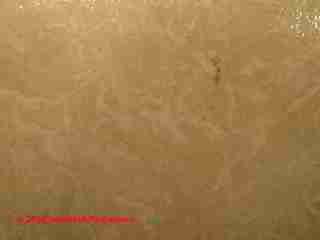
This Armstrong flooring tile is 12" x 12" x 1/16" or 1.5mm thick.
Unlike the older vinyl-asbestos floor tiles whose photographs we provide below, this more recent flooring product is built from a thin vinyl layer containing the tile's design pattern and a fiber/paper backer (shown in our photo above) to which an adhesive was coated so that the tile could be installed without use of a mastic.
A typical pattern is the embossed design shown at left.
The floor tile thickness (about 1.5mm or 1/16") suggests that this product was produced after 1980 and probably does not contain asbestos.
Below we show a photo of the Armstrong© Stamp found on the under-side or "back" of 12 x 12 "stick-on" self-adhesive floor tiles produced by Armstrong.
Depending on the age of manufacture, some paper-backed flooring products used asbestos as a primary ingredient (see Asphalt & Vinyl Floor Tile History). Tests of our example floor sample (above) for asbestos confirmed that some early peel-and-stick floor tiles sold in the 1980's did contain asbestos.
Contemporary resilient flooring products do not contain asbestos however.
Shown at above left: Armstrong Excelon Vinyl Floor tile, contemporary, popular, sold in 70 colors at retail outlets including Home Depot stores, this modern resilient floor tile does not contain asbestos. [Click any image to see an enlarged, detailed version].
Reader Question: Asbestos in Armstrong's Vernay flooring products?
 Hello - here is a picture of an Armstrong self-stick floor tile. These were installed on a garage floor and are loose since moisture builds up under them.
Hello - here is a picture of an Armstrong self-stick floor tile. These were installed on a garage floor and are loose since moisture builds up under them.
The building was built in 1984, however, I don't think these floor tiles were installed until after the house was constructed.
We found them glued to cabinet shelves also. Would these contain asbestos - they are very thin. - P.S. 1/6/2014
Reply:
You'll be happy to know that in our article above on this page one can recognize the floor tile pattern in your photograph as Armstrong's Vernay line.
In this article near the top of this page we report that Armstrong reports that the tile you show, in the Vernay pattern line, was introduced in 1980 and discontinued in 1982. According to the manufacturer, this product never contained asbestos.
It is worth noting that your photo and example, combined with your observation that the tile in your photograph was found in a building built in 1984 prove the point that "new old stock" floor tiles may be installed several years after the flooring product was actually manufactured.
(For other readers, I am doubtful that the thickness of floor tiles itself is a good criteria for opining that the material is asbestos free.)
A catalog of floor tile identification photographs for products that contained asbestos, 1952 - 1980, is provided
at ARMSTRONG VINYL-ASBESTOS FLOOR TILE ID CATALOG - 1952 - 1986.
And at ARMSTRONG FLOORING HISTORY we provide a history of Armstrong flooring and links to company information.
CONTACT US or better use the page-bottom Add Image button to send a photograph of your own floor tile pattern or for assistance in identification if you can't find your floor tile image, pattern, or design in this floor tile color and pattern library.
How to Find Your Floor Tile or Sheet Flooring in this Flooring Reference Photo Guide
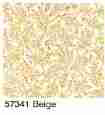
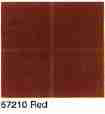
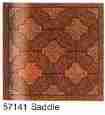
Asphalt asbestos and vinyl-asbestos floor tiles were produced in 9" x 9", 12" x 12", and even 18" x 18" as well as in decorative strips, and in thicknesses of 1/16", 3/32", and 1/8", also in 0.08 gauge. Some sheet flooring or resilient flooring also contained asbestos, as did floor tile mastics.
This photo guide to asphalt asbestos & vinyl asbestos floor tiles for each year shows at least one color photo of each floor tile style or pattern in an example color. A list below each group of photos includes the names of and links to additional photos for other colors of these styles.
Asbestos is safe and legal to remain in homes or public buildings as long as the asbestos materials are in good condition and the asbestos can not be released into the air.
To identify a particular asphalt-asbestos or vinyl-asbestos floor tile pattern & color, start in the image group most likely to be the same age as your building.
If you don't find your floor tile or sheet flooring by looking forward from that that year, you should also look backwards in the earlier years as your specific flooring pattern & color may have first appeared in an earlier year. For other tile brands than Armstrong, see the brand name floor tile links included in this list.
Research on Asbestos Content in Armstrong Self-adhesive & Other Flooring Products
- Armstrong Corporation, "ARMSTRONG PREMIUM TILE FLOORING and ALTERNA™ Groutable Vinyl Tile
Installation and Floor Care Instructions" [PDF] (2013), AWI Licensing Company, retrieved 2017/09/05, original source:
https://www.armstrongflooring.com/content2/flooring/files/93391.pdf Excerpt from a 2013 insert included with flooring that does NOT contain asbestos:
WARNING: EXISTING IN-PLACE RESILIENT FLOOR COVERING AND ASPHALTIC ADHESIVES. DO NOT SAND, DRY SWEEP, DRY SCRAPE, DRILL, SAW, BEADBLAST, OR MECHANICALLY CHIP OR PULVERIZE EXISTING RESILIENT FLOORING, BACKING, LINING FELT OR ASPHALTIC “CUT-BACK” ADHESIVES.
These existing in- place products may contain asbestos fibers and/or crystalline silica refer to the caution section below.
Avoid creating dust, inhalation of such dust is a cancer and respiratory tract hazard. Smoking by individuals exposed to asbestos fibers greatly increases the risk of serious bodily harm. Unless positively certain that the existing in-place product is a non asbestos -containing material, you must presume it contains asbestos.
Regulations may require that the material be tested to determine asbestos content and may govern removal and disposal of material.
See current edition of the Resilient Floor Covering Institute publications recommended work practices for removal of resilient floor coverings for instructions on removing all resilient floor covering structures. Contract your retailer or Armstrong World Industries Inc. 1 800 233 3823 for questions. The floor covering in this package does NOT contain asbestos.
Reader Comments, Questions & Answers About The Article Above
Below you will find questions and answers previously posted on this page at its page bottom reader comment box.
Reader Q&A - also see RECOMMENDED ARTICLES & FAQs
On 2023-01-12 by InspectApedia Publisher - vinyl sheet flooring
@Sam,
So it's vinyl sheet flooring - my mistake: you are posting on a "peel and stick tile" flooring page.
Please read my best advice for your situation, found at
ASBESTOS FLOORING HAZARD LEVEL ASSESSMENT
and
ASBESTOS FLOORING HAZARD REDUCTION
On 2023-01-12 by Sam
@InspectApedia Publisher,
Thank you for getting back to me. It actually isn't a peel and stick. It looks like it was glued down and cut o the size of the room.
Is it something that I should reach out to the landlord about?
On 2023-01-11 by InspectApedia Publisher
@Sam,
That's not a 1950s flooring but it could be old enough (USA before 1986) to contain asbestos. Some peel-and-stick floor tiles form the 1970s and early 80's contained asbestos.
Avoid making a dust out of the flooring and you're minimizing risk.
In the list of Recommended Articles above on this page, see also
DOES THIS FLOOR CONTAIN ASBESTOS? - 5 easy questions to tell if your FLOOR probably contains asbestos
On 2023-01-11 by Sam
Hello! I have this flooring in my apartment in Maine. It looks like a peel and stick. I saw that there was a renovation listed online in 1950.
The flooring is in the kitchen. All the edges have extra length and curl at the edges. The backing looks like gray paper, and the middle layer looks like a sparkly and chalky white.
I sometimes hit it with a broom or kick it on accident since it curls out.
Does it look suspicious at all?
In theory, how high is the exposure risk?
Here's an overall pattern picture as well.
On 2022-09-24 by InspectApedia-911 (mod)
@Arc,
There are indeed similar floor tiles as those in this article series. When the tiles are a peel and stick type the asbestoses not likely to be in the adhesive. Rather it's in the tile or tile backer.
And if you want to consider leaving that flooring in place if it's in good condition, please take a look at
HOW TO SEAL ASBESTOS FLOOR TILES
On 2022-09-24 by Arc
These tiles are in the basement of my new (first!) home. House was built 1938, but they were likely installed in the early 70s, based on the style and when the basement had other updates (previous owners bought in '65, lots of wood paneling down there, gas heater installed 1972). Tested with a lab, came back 2% chrysotile. No mastic, seem to be peel-and-stick, no backing I can see.
I haven't been able to find anything remotely like these no matter how hard I search, and I'm wondering if the asbestos found in the test is likely to be in the tiles themselves or in the adhesive. (I almost wish I could keep them - they're pretty - but they're chipping a bit and I don't want to risk them getting dust anywhere.) If you can tell me anything else about them, I'd be curious to know as well. I can add more info or pictures if you need.
Thanks in advance!
On 2022-09-10 by InspectApedia-911 (mod) - jute backed sheet flooring
@Matt,
Peel and stick vinyl floor tiles like those in your photo, if your building is in the U.S., probably date from the 1970s or later.
The backing in your photo looks like a white material - not jute. Though I note that SOME sheet flooring and floor tiles included a white backer that was the final bottom layer of a jute-reinforced flooring product.
Jute is a plant fiber based fabric, typically brown and rough woven. I include an example photo of the under-side of jute-backed linoleum flooring below.
You can see examples of jute flooring backing at
BURLAP OR JUTE BACKED SHEET FLOORING
The backer on your floor tiles may contain asbestos.
There is little justification for testing that floor for asbestos unless you have no choice but to perform a dust-creating aggressive demolition of the floor.
If the tiles simply lift-up, dispose of them as construction waste.
If the tiles are well adhered, leave them in place and cover them with other flooring.
On 2022-09-10 by Matt
I found these tiles in a shed on the property I just bought (the house was built in the 1920s; though it has clearly been changed over the years). I haven't found them installed anywhere in the house yet. There was no box. They are 9" square and appear to have a jute backing.
Does anyone recognize them and/or can tell me if they do not contain asbestos, or is it worth it to get them tested?
Thank you for any help!
On 2021-10-31 by inspectapedia.com.moderator - Armstrong 12 x 12 peel and stick tiles -Item 28261
@Paula,
Short of calling Armstrong, which might be your best bet, you should see the live link above titled
DOES THIS FLOOR CONTAIN ASBESTOS? - 5 easy questions to tell if your FLOOR probably contains asbestos
On 2021-10-30 by Paula
I have 4 boxes of Armstrong 12 x 12 peel and stick tiles -Item 28261 They are dark grren and white suares could you tell me if they contain asbestos and approx what date they were made
On 2021-06-27 by inspectapedia.com.moderator
@Elizabeth,
The best you can do is to see what additional context you will information you can provide about that floor. Or have it tested. See
DOES THIS FLOOR CONTAIN ASBESTOS? - 5 easy questions to tell if your FLOOR probably contains asbestos
For which a live link is given just above
On 2021-06-27 by Elizabeth
Please see attached picture.. this is a 12x12 peal and stick type tile, it’s still pretty tacky on the back. We found it under some old carpet on basement stairs. It was already cracking and chipped from the nails and staples used on the carpet.
It breaks easily and there is no legible letters or numbers on the back. There is a different style tile on the basement floor that was also under the carpet which we already had tested for asbestos and was negative. (Our house was built in 1970) We did not know there was more tile under the stairs so we did not test it.
Wondering how likely it is that this particular tile has asbestos since I’ve been ripping up the carpet and the tile is braking, worried about exposure of it is asbestos.
On 2021-06-27 by inspectapedia.com.moderator
@Gail,
1991 floor tiles in North America will not contain asbestos
On 2020-12-30 by Gail
I have the box for some tiles that are in my bathroom under a newer subfloor that I just tried to remove. How can I search if they are asbestos?
Box had date of 6-11-91 and 3/91 as well as 213931 and 393A
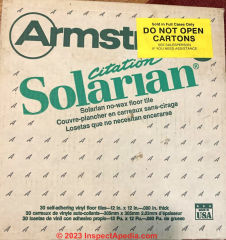
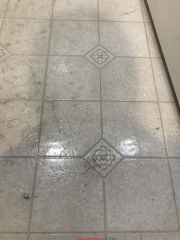 On 2020-08-31 - by (mod) - peel and stick floor tiles from the 1970s up to late 1980s may contain asbestos
On 2020-08-31 - by (mod) - peel and stick floor tiles from the 1970s up to late 1980s may contain asbestos
Probably 1970s or later, Chen.
On 2020-08-30 by Chen
What era is this flooring from? Likely peel and stick vinyl. Thank you.
Do you think this flooring contains asbestos? Previous owner lined bottom of cabinets under sinks with remnants. Looks like peel and stick under the sink.
On 2020-08-03 - by (mod) - asbestos in Place-n-Press floor tiles
Javi4r
That floor may contain asbestos. Please see
DOES THIS FLOOR CONTAIN ASBESTOS? - 5 easy questions to tell if your FLOOR probably contains asbestos
On 2020-08-02 by Javier
Hello! Just bought a 1925 and redoing floors. Found this flooring in a couple of closets, no idea from when.
On the back it says place n press 4 0123060999, didn’t come up in any searches. Previous owner bought the place in 2000 and has no idea when they were installed. Thanks
On 2020-07-22 - by (mod) -
Try using the add image button to post photos, one for comment, of all of the sides of the box and it's writing as well as have any markings on the back of your floor tiles and perhaps we can find more specific information.
On 2020-07-22 by K
Hello, I'm not sure of the time period but I have a box full of extras found in the basement!
On 2020-07-02 - by (mod) -
If you're reasonably sure it's late 1980s then the floor is not at all likely to contain asbestos. The problem with reaching to Armstrong is that if it's a pattern that was made over multiple years and you don't have a date they're not going to know without a lab test.
On 2020-07-02 by Drew
I wish I had more details on the age or when the floor was installed. I looked through several of the tiles I have, but could not find a product # or date. The floor is installed in a basement that had a laminate floor over layed on it. However part of the floor was removed at one point when the bathroom was incorporated into the basement space.
The last owner of my house move in 10-years ago. I presume he installed the hardwood. I also have the feeling that the different floors could have also been a means to improve the value of the basement space. Thanks for your quick response.
Have you had luck reaching out to Armstrong or any manufacturers to confirm the year (or timeframe) this pattern was manufactured?
For whatever reason, I feel like it was a late 80s or early 90s upgrade, but I cannot be for sure.
On 2020-07-02 - by (mod) - handling asbestos-suspect 12x12 peel and stick floor tile
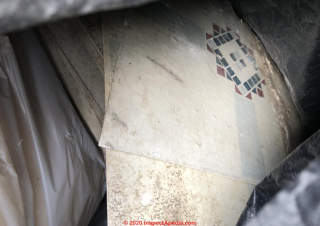 Drew
Drew
In part because popular patterns were produced in both asbestos- and non-asbestos-containing versions, I prefer to have an idea when the particular floor in question was installed or manufactured. We rely on building age and history and occasionally get lucky with a date code on the product or its packaging.
If the floor was made after the mid 1980s it's not likely to contain asbestos.
If you want to be prudent you either treat the floor as presumed to contain asbestos or have a sample tested.
In my OPINION, handling an intact floor tile in the course of lifting it into a construction debris bag, that is not grinding, chopping, making a dusty mess of it, is not likely to produce a measurable airborne asbestos hazard.
More detailed advice is in the More Reading links to this article at
On 2020-07-02 by Drew
Curious about this particular floor tile (12x12, 1/16" thickness) found in my house. [shown above]
The back of the tiles are grey with digitized writing stating the KB (in circles) and Armstong. It looks to be a vinyl peel and stick tile from Armstrong, based on the writing mentioned previously.
Tried to research and figure out the age of the tile to know if it does or does not contain asbesto. Secondly, is the concern with disturbance if the tiles is broken? Does handling a fully intacted tile pose an issue?
On 2020-07-01 - by (mod) - Do Domco Belmont Nite 51228 0197 "Self Stik" tiles contain asbestos?
Mike
when were the tiles manufactured?
and can you attach photos (one per comment) of any box labels or tile markings? I'm not finding the manufacturer "Domcon Belmont" floor tiles
On 2020-07-01 by Mike
Self stick vinyl tiles & asbestos - Do Domco Belmont Nite 51228 0197 "Self Stik" tiles contain asbestos?
On 2019-10-07 - by (mod) - asbestos-suspect mobile home floor tiles
MIchelle,
From my limited view of the flooring in your photo, yes your flooring might contain asbestos, but without at least a little basic information any assertion would be mere arm-waving.
You should review DOES THIS FLOORING CONTAIN ASBESTOS?
to make a better guess. Let me know what you think after you've seen the 5 easy questions posed there.
On 2019-10-07 by Michelle
We just purchased a home that has the pictured vinyl tile that they started to remove. Does it contain asbestos?
On 2019-07-28 by (mod) - asbestos in Armstrong "J" Floor Tile
I can't say that I recognize that Armstrong flooring pattern either, although it's a bit indistinct in the photo.
If the Armstrong peel and stick flooring was manufactured in 1986 or before it possibly contains asbestos.
It would be prudent to either treat the floor is presumed to contain asbestos or if you can't avoid making a Dusty mess then have a sample tested.
The best approach is to leave it in place and cover it over in any case.
On 2019-07-27 by Kelly
Our house was built in 1937 and remodeled in 1987. This flooring is upstairs and I wanted to know if it contains asbestos.
I have searched the site but can't find it anywhere. We want to pull it up and get back to original wood floors. The back side simply has Armstrong, an arrow and the letter "J".
On 2019-07-01 - by (mod) - Asbestos in Self-Stick or "peel-and-stick" floor tiles from Armstrong
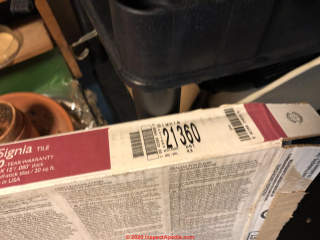 Gary
Gary
We found asbestos in Armstrong peel-and-stick flooring up into at least the early 1970s including some 12x12 floor tiles as well as other sizes.
It is of course a newer product than your 1940's house itself.
You might find an earliest and last manufacture date for the product in your photo by researching the bar code itself. However if the box warns that the product contained asbestos then it almost certainly does. You should treat the floor as presumed to contain asbestos, or have a sample tested.
You should review DOES THIS FLOORING CONTAIN ASBESTOS?
Asbestos is safe and legal to remain in homes or public buildings as long as the asbestos materials are in good condition and the asbestos can not be released into the air.
Finally, it would be most helpful if you could post a photo (one per comment) of the floor tile pattern or face, as well as of any markings on the floor tile back side.
On 2019-06-30 by Gary H
We have this Armstrong Signia floor tile in our bathroom that was existing when we bought the house. We have the box that was left by the installer before we bought the house in 2010. The house is from the 1940s.
The box actually warns about the hazard of asbestos in removing existing floor coverings, but we still would like to be certain that this tile in our bathroom is safe before we remodel.
The image attached is from the box and shows some model info.
I have been unable to find anything online about it. It is 12 x 12 .080" thick peel and stick. If you any details about the sate of manufacture or content we would be grateful. Thanks.
On 2019-02-02 14:13:05.757487 - by (mod) -
Elizabeth
If you are confident that the flooring was manufactured after 1985 there is little chance that it contains asbestos.
On 2019-02-02 13:44:31.169518 by Elizabeth
I wonder if you could please be of help. I have Armstrong Place 'n Press vinyl tiles in my kitchen which were laid in the mid 1980s. I am wondering whether or not they contain asbestos.
IMAGE LOST by older version of Clark Van Oyen’s useful Comments code - now fixed. Please re-post the image if you can. Sorry. Mod.
...
Continue reading at DOES THIS FLOOR CONTAIN ASBESTOS? - 5 easy questions to tell if your FLOOR probably contains asbestos or select a topic from the closely-related articles below, or see the complete ARTICLE INDEX.
Or see SELF ADHESIVE PEEL & STICK ASBESTOS TILE ID FAQs - Q&A posted originally at this page
Or see these
Recommended Articles
- ASBESTOS DISPOSAL REGULATIONS
- ASBESTOS FLOOR TILE COMPOSITION
- ASBESTOS FLOORING DAMAGE HAZARDS
- ASBESTOS FLOORING HAZARD LEVEL ASSESSMENT
- ASBESTOS FLOORING HAZARD REDUCTION
- ASBESTOS FLOOR TILE IDENTIFICATION COLOR KEY - home
- ASBESTOS FLOORING IDENTIFICATION GUIDE INDEX - all brands, all years
- ASBESTOS FLOORING REMOVAL GUIDE
- ASBESTOS REMOVAL, WETTING GUIDELINES
- ASBESTOS RISK ASSESSMENT
- ASBESTOS TESTING LAB LIST
- DOES THIS FLOOR CONTAIN ASBESTOS? - 5 easy questions to tell if your FLOOR probably contains asbestos -
- DOES THIS MATERIAL CONTAIN ASBESTOS? - 5 easy questions to tell if a BUILDING MATERIAL probably contains asbestos -
- MARBLE / STONE CHIP PATTERN FLOORING ASBESTOS
- RESILIENT SHEET FLOORING ID GUIDE
Suggested citation for this web page
SELF-ADHESIVE PEEL & STICK ON ASBESTOS TILE IDENTIFICATION at InspectApedia.com - online encyclopedia of building & environmental inspection, testing, diagnosis, repair, & problem prevention advice.
Or see this
INDEX to RELATED ARTICLES: ARTICLE INDEX to ASBESTOS HAZARDS
Or use the SEARCH BOX found below to Ask a Question or Search InspectApedia
Ask a Question or Search InspectApedia
Questions & answers or comments about asbestos in peel and stick flooring materials & flooring made or sold in the U.S., Canada, or other countries after 1980.
Try the search box just below, or if you prefer, post a question or comment in the Comments box below and we will respond promptly.
Search the InspectApedia website
Note: appearance of your Comment below may be delayed: if your comment contains an image, photograph, web link, or text that looks to the software as if it might be a web link, your posting will appear after it has been approved by a moderator. Apologies for the delay.
Only one image can be added per comment but you can post as many comments, and therefore images, as you like.
You will not receive a notification when a response to your question has been posted.
Please bookmark this page to make it easy for you to check back for our response.
Our Comment Box is provided by Countable Web Productions countable.ca
Citations & References
In addition to any citations in the article above, a full list is available on request.
- Armstrong ® Residential Flooring - Website 05/15/2010 https://www.armstrongflooring.com/ lists current flooring products provided by the Armstrong Corporation, including Armstrong's current vinyl floor tile products at https://www.armstrongflooring.com/flooring/products/vinyl-floors
- Armstrong Corporation, Corporate History - https://www.armstrongflooring.com/corporate/corporate-history.html - Web Search 05/19/2010
- Armstrong vinyl asbestos floor tiles: photos of asbestos-vinyl floor tiles as catalog pages (PDF form) are at www.asbestosresource.com/asbestos/tile.html
- "Asbestos in your home or at work," Forsyth County Environmental Affairs Department, Winston-Salem NC 12/08
- "Asbestos Floor Tile Removal", the University of Minnesota's advice on removing VAT (vinyl asbestos or asphalt asbestos floor tile) can be read in detail at www.health.state.mn.us/divs/eh/asbestos/floortile/index.html
- EPA, ASBESTOS IN YOUR HOME [PDF] - U.S. EPA, Exposure Evaluation Division, Office of Toxic Substances, Office of Pesticides and Toxic Substances, U.S. Environmental Protection Agency, Washington,D.C. 20460
- Resilient Floor Covering Institute, 1030 15th St. NW, suite 350, Washington D.C.
- Book Recommendations for Asphalt & Vinyl-Asbestos Floor Tile Identification:
- Inspiring Interiors from Armstrong 1950s from Armstrong, [Paperback], Schiffer Publishing (March 1998), ISBN-10: 0764304585, ISBN-13: 978-0764304583
- Interior Solutions from Armstrong the 1960s from Armstrong, [Paperback], Schiffer Publishing (March 1999), ISBN-10: 0764307002, ISBN-13: 978-0764307003
- Mechanix Illustrated How-to-do-it Encyclopedia Vol 2. -1961
- Congoleum Corporation, "Company History", Congoleum Corporation, Department C, P.O. Box 3127, Mercerville, NJ 08619-0127 1-609-584-3601, web-search 03/14/2011, original source: http://www.congoleum.com/history.html
- David Grudzinski, Advantage Home Inspections, is a professional home inspector in Cranston, RI. 02910. He can be reached at 401-935-6547, fax- 401-490-0607 or by email to contact/us@advantagehomeinspections.us 04/26/2009
- EPA Guidance for Controlling Asbestos-Containing Materials in buildings, NIAST, National Institute on Abatement Sciences & Technology, [republishing EPA public documents] 1985 ed., Exposure Evaluation Division, Office of Toxic Substances, Office of Pesticides and Toxic Substances, U.S. Environmental Protection Agency, Washington,D.C. 20460
- EVER WEAR TILE CO is currently (2009) in the Terrazzo, Tile, Marble, and Mosaic Work industry in Fallon, NV. 775) 423-6221. [We do not know the company history nor whether there is an association with EverWear vinyl asbestos floor tiles discussed in this article.]
- Kentile KenFlex flooring photographs:Flickr web search 5/15/2010 - see original material and other asbestos product photos
- "Plastic Flooring Spreads Through the House", Jackson Hand, Guide to Home-Improvement Materials, Popular Science, April 1969, p. 154-158
- Thomas Hauswirth, Managing Member of Beacon Fine Home Inspections, LLC and (in 2007) Vice President, Connecticut Association of Home Inspectors Ph. 860-526-3355 Fax 860-526-2942 beaconinspections@sbcglobal.net 06/07: thanks for photographs of transite asbestos heating ducts
- Gary Randolph, Ounce of Prevention Home Inspection, LLC Buffalo, NY, for attentive reading and editing suggestions. Mr. Randolph can be reached in Buffalo, NY, at (716) 636-3865 or email: gary@ouncehome.com 3/07
- Thanks to reader Matt Abel, Design Services Department, Strongwood Log Home Company, 711 Shadow Road, Waupaca WI 54981, Office (715) 258-4818, Toll Free (866) 258-4818, www.gostrongwood.com "Begin your journey home.." for vinyl asbestos floor photos, October 2010.
- Thanks to reader Meryl Silvers for hexagonal floor tile photos showing a possible Kentile product that contained asbestos. October 2010.
- Thanks to reader N.H. for providing a photo of 1970's era vinyl asbestos floor tile that we identify as most likely Armstrong Solarian Devonport white.
- M.B. provided photographs of Congoleum linoleum flooring from a 1960's Tampa Florida home.
- June 1997 - Window Putty - OSHA case cites contractor for asbestos exposure during removal of window putty http://www.osha.gov/pls/oshaweb/owadisp.show_document?p_table=NEWS_RELEASES&p_id=1091
- ASBESTOS IN YOUR HOME U.S. EPA, Exposure Evaluation Division, Office of Toxic Substances, Office of Pesticides and Toxic Substances, U.S. Environmental Protection Agency, Washington,D.C. 20460
- Asbestos products and their history and use in various building materials such as asphalt and vinyl flooring includes discussion which draws on ASBESTOS, ITS INDUSTRIAL APPLICATIONS, ROSATO 1959, D.V. Rosato, engineering consultant, Newton, MA, Reinhold Publishing, 1959 Library of Congress Catalog Card No.: 59-12535 (out of print, text and images available at InspectAPedia.com).
- "Handling Asbestos-Containing roofing material - an update", Carl Good, NRCA Associate Executive Director, Professional Roofing, February 1992, p. 38-43
- EPA Guidance for Controlling Asbestos-Containing Materials in buildings, NIAST, National Institute on Abatement Sciences & Technology, [republishing EPA public documents] 1985 ed., Exposure Evaluation Division, Office of Toxic Substances, Office of Pesticides and Toxic Substances, U.S. Environmental Protection Agency, Washington,D.C. 20460
- In addition to citations & references found in this article, see the research citations given at the end of the related articles found at our suggested
CONTINUE READING or RECOMMENDED ARTICLES.
- Carson, Dunlop & Associates Ltd., 120 Carlton Street Suite 407, Toronto ON M5A 4K2. Tel: (416) 964-9415 1-800-268-7070 Email: info@carsondunlop.com. Alan Carson is a past president of ASHI, the American Society of Home Inspectors.
Thanks to Alan Carson and Bob Dunlop, for permission for InspectAPedia to use text excerpts from The HOME REFERENCE BOOK - the Encyclopedia of Homes and to use illustrations from The ILLUSTRATED HOME .
Carson Dunlop Associates provides extensive home inspection education and report writing material. In gratitude we provide links to tsome Carson Dunlop Associates products and services.



